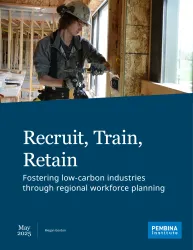Canadians are ready to grow our economy. Many, including our new federal government, see an urgent need to accelerate the kind of nation-building projects that will connect the country, strengthen the economy and protect our national interests. These projects — especially those that support clean energy, climate resilience and economic security — could create a wave of well-paying, sustainable jobs across the country.
Bold infrastructure investment creates an opportunity. But to make the most of it, we need a clear strategy to recruit, train and retain the workforce that will bring these projects to life — and ensure the benefits reach everyday Canadians.
The good news is that the federal government already has a vehicle to deliver one: the Sustainable Jobs Action Plan, due by the end of 2025 under the Sustainable Jobs Act. Passed in 2024, the Act commits the federal government to preparing action plans every five years to support workers as the economy transitions to net-zero. That means bringing workers to the table, helping them build the skills they need to thrive in a clean economy and supporting them as their industries transform and change. This first Action Plan will shape the next five years of Canada’s climate transition, so it’s critical that we get it right.
Canada is already facing a growing shortage of skilled labour — a trend poised to continue as baby boomers retire over the next decade. At the same time, the nature of work is shifting as industries adopt new technologies and move towards decarbonization, requiring workers to continuously upgrade and expand their skills. Governments should provide clearer guidance on how workers can get involved in these projects and what occupations and skills will be most in demand. These questions are especially urgent for workers facing job loss as a result of tariff-induced economic strain.

Our new report Recruit, Train, Retain assesses the current workforce development policy landscape in Canada, identifies best practices used to address labour market challenges, especially in skilled trades, and outlines policy recommendations to support sustainable jobs growth. With thoughtful planning, these major public investments can translate into lasting, high-quality jobs for Canadian workers and help ensure that no region or community is left behind.
Collaboration is key to workforce readiness
Our report finds that governments play a key role in facilitating collaboration between labour, post-secondary institutions and employers, in addition to leveraging public financing to incentivize private sector investment in industry-aligned training programs. As post-secondary institutions face financial pressures, there is an opportunity to provide them with a clearer mandate tied to clean economy goals, helping institutions access funding and develop programs that build the skills, knowledge and innovation needed for a prosperous clean economy.
Labour organizations and unions bring decades of insights into protecting workers’ rights, securing social protections, and implementing comprehensive training approaches — while avoiding excessive micro-credentialling that can limit career growth and mobility. Employers, in turn, are attuned to the specific skills and occupations their workforce needs to succeed.
Bringing these groups together through models such as innovation clusters and workforce hubs can more effectively address labour market challenges, make better use of resources and support long-term workforce growth.
For success stories, we looked to sectors that have taken multi-pronged approaches. For example, The Athena Pathways program — developed through the Digital Technology Cluster, a government-funded tech development accelerator that has produced several skill-building initiatives in collaboration with industry and educational institutions — used a multi-stage approach to improve gender equity in tech. It included outreach to high school students, education programs for middle school through university, and leadership workshops for mid-career women, helping address persistent gender imbalances in a male-dominated sector. This type of approach holds lessons for the skilled trades as well, which continue to face gender imbalances and could benefit from similar programs.
In Ontario, the province responded to healthcare labour shortages with a suite of strategies to improve recruitment, training and retention. The Long-Term Care Staffing Plan included incentives to attract workers to high-need regions and created streamlined pathways to employment. Programs like the Supervised Practice Experience Partnership have enabled internationally trained nurses to demonstrate their skills under supervision, accelerating credential recognition. As much of Canada’s future workforce growth is expected to come from immigration, strategies like these will be just as important for scaling up the skilled trades.
These examples show how targeted, multi-stage strategies can successfully expand and diversify the workforce. Similar approaches can be adapted to support workforce development in the clean economy, helping energy and industrial sectors build the talent they need for a successful, inclusive transition.
Now is the moment to get workforce planning right
As Canada begins to accelerate infrastructure development, the need for a robust, inclusive workforce plan becomes more urgent. Projects designed to support the clean economy must be backed by policies that ensure workers are ready to build and sustain them.
By drawing on lessons from our report — and by learning from what’s worked — the federal government has a timely opportunity to develop a workforce plan that meets the moment through the Sustainable Jobs Action Plan. One that ensures public investments in infrastructure lead to lasting, high-quality jobs and shared prosperity across the country.
Explore the policy recommendations
- Explore our full recommendations, read our report: Recruit, Train, Retain: Fostering low-carbon industries through regional workforce planning
- See also our Sustainable Jobs Blueprint: Summary Report












